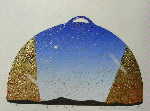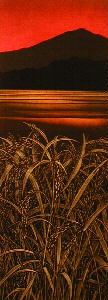![]()
![]()
![]()
![]()
![]()
![]()
Search | Order
| What's New
|
|
A Far Eastern PerspectiveWindows to a vibrant culture: as seen in the works of four artists selected from the prestigious 2001 CWAJ show in JapanLithographs, intaglio relief, woodcut/collograph and mezzotint are the among the mediums employed by artists Susumu Endo, Margaret Kennard Johnson, Yoshikatsu Tamekane, and new to the gallery, Katsunori Hamanishi |
|
Space & Space 99C © 2001 Susumu Endo |
November 24th through December 22nd, 2001Opening & Gallery Talk by Margaret Johnson:
|
|
Into the Unkonwn - II © 2000 Margaret Kennard Johnson |
 Baggage III © 1999 Yoshikatsu Tamekane |

About the Exhibit:
Japanese printmaking is well known for it’s age old adherence to artistic excellence
and attention to detail, along with the desire of each artist to incorporate in their work
the underlying richness of their social and cultural heritage. Today’s Japanese
artist seeks to retain these principles while often, at the same time, incorporating new
techniques and ideas with the old.
"ars sine scientia nihil (art without knowledge is nothing)"
Jean Vignot 1390
Works by three of Japan's most esteemed printmakers, Endo, Hamanishi and Tamekane, and an American artist (Margaret Kennard Johnson) who is strongly influenced by Japanese traditions are on view at the Williams Gallery. Ms. Johnson, who has created art, lived and studied in Tokyo, will be present at the opening reception on Saturday, November 24. She will share with us some of her experiences in Japan while visiting artists’ studios, observing printmaking techniques and sharing the ideology and intent of the artists in the current exhibit. Ms. Johnson has recently exhibited her own works in Japan, and is presenting, in absentia, the opening talk at this November’s CWAJ (College Women's Association of Japan), a national juried show where renowned and up and coming Japanese artists exhibit their newest works.
Contemporary prints from Japan have received wide recognition internationally, and the artists are the recipients of an extraordinary number of honors and prizes at exhibitions throughout Europe, North and South America and Asia. The current exhibit at The Williams Gallery is a cause for celebration in that the gallery is one of the few in the United States where such a wide collection of work by these innovative printmakers is displayed. Each of the artists in "A Far Eastern Perspective" has their own unique style and medium. Yet each respects and incorporates the Japanese aesthetic of supreme craftsmanship and attention to detail while simultaneously bringing contemporary techniques and culture into their work.
About the Artists:
Susumu Endo blends photographic and non-photographic processes via computer, mixing
the reality of the natural landscape with abstraction to create a singular surrealistic
image – a mingling of a nature and space continuum. Born in 1933, Endo came to
printmaking by way of graphic design. He uses the computer as a tool to enhance and
manipulate his already exquisite photographs and drawings, often reversing images and
modifying color so that dark becomes light or red becomes green. Such reversals create
visual tensions between the negative and positive that have earned him the title of
conjurer and magician. Endo's images employ a skill and beauty that challenge our sense of
reality. In contrast with Endo’s use of leading edge technology his work evokes a
meditative serene quality akin to the atmosphere of a traditional Japanese tea ceremony.
To Endo the tea ceremony is a vital part of his life.
Like the surrealistic paintings of Dali and Magritte, Katsunori Hamanishi's
mezzotints juxtapose nature and abstraction. In "Division - Work No. 75," for
example, bold green abstract shapes marked by thin curved lines bump up against fields of
rice and grain. Hamanishi's prints are noted for their delicate details and velvety blacks
– a result of his mastery of the mezzotint process. After an artist's residence at
the University of Pennsylvania, Hamanishi began to inject bold but judicious bits of red
into his mezzotints. His works have only continued to intrigue as they have evolved. Using
the Western process (mezzotint)with local imagery (clusters of rice stalks) in his
compositions, they are at the same time, fresh and new while harking back to the
traditional ‘Kabuki’ in their stylization.
An esteemed reputation in intaglio and relief printmaking was already in place when Margaret
Kennard Johnson and her husband re-located to Japan in 1975, where they lived for
eight and a half years. As a teacher at the Museum of Modern Art in New York, Ms. Johnson
handed down lessons she herself learned studying under Josef Albers years before at Black
Mountain College in North Carolina. (Albers had taught at the Bauhaus in Germany). She has
described her tenure in Japan as a time of re-awakening, as though she was seeing things
through the eyes of a child. Ms. Johnson absorbed the Eastern aesthetic of simplicity,
incorporating this knowledge into her works. Printmaking processes and the materials
themselves, which manifest a vibrant yet subtle dialogue between paper and ink, guide Ms.
Johnson's visual expressions. Her most recent hand made paper works and original intaglio
prints will be represented in this show.
Born in 1959, Yoshikatsu Tamekane studied at Sokei Academy of Fine Arts in Tokyo. He is a member of the Japan Print Association and has shown seven consecutive years in the prestigious CWAJ Print Show. He is known for his combination of technical prowess with a mystical aesthetic and vision. He frequently adds rich textural qualities, such as silver and gold leaf, to his woodblock images. He incorporates an intaglio printing method from a block to which pieces of cardboard or other materials are applied. The raised surfaces are inked and printed. Tamekane's use of deep reds, black and gold provides the background on which float musical notations, cosmic images of horizons, stars and other celestial objects. Works like "Neptune" and "Traveling Seed" are colorful, provocative and meticulously executed. The wood blocks of Tamekane explore a variety of themes, including Time and Space. He explains:
"I savor the past and also look forward to the next century as a time of hope and advancement for the human spirit".
Home Page
| Artwork
| Framing
| Restoration
| Shows & Events
| Online Store
| Master Works
| Pioneers
| Princeton
Willard Page Collection
| William Bock's Fine Art Catalog Rasoniee
Contact Us
| About Us
| Art Links